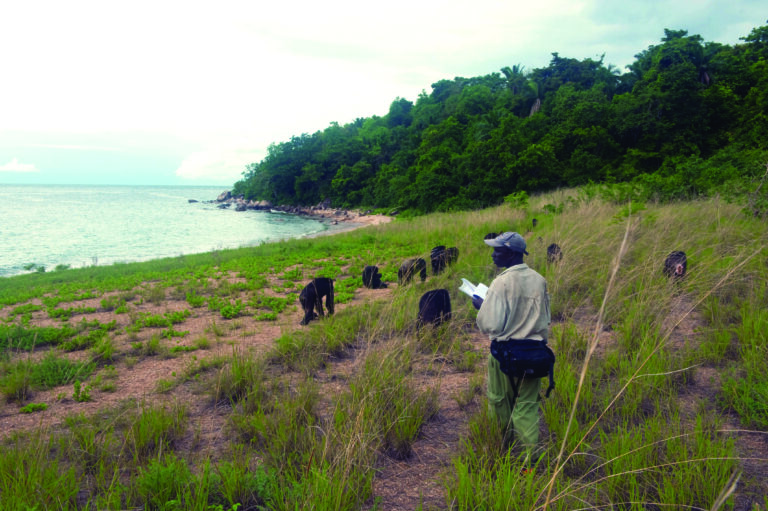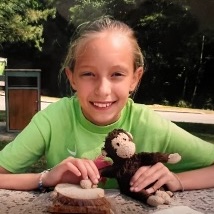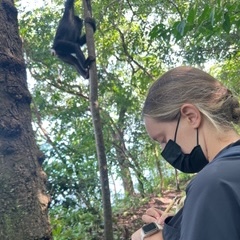July 14, 2025 celebrates not only 🔗 World Chimpanzee Day, but also the 65th anniversary of research at what is now Gombe National Park in Tanzania. What began with Dr. Jane Goodall trekking into the forest to learn about chimpanzees continues to this day in what is now the longest-running wild chimpanzee study in the world. This research has expanded to include an extensive baboon study, and now incorporates cutting-edge technology, such as using Geographic Information Systems to map and track habitat changes, bioacoustics monitoring of the rest of Gombe’s fauna, and so much more.
Our insights into Gombe’s unique ecosystem would not be possible without the dedicated scientists at JGI’s Gombe Stream Research Center. Over the past 65 years over 200 researchers and field assistants have conducted research in Gombe, including generations of local Tanzanian scientists, long-term university partners, and more. Their stories are what bring Gombe to life, so we asked several of these Gombe scientists to share their stories with us.
Dr. Thomas Gillespie
Professor and Chair at Emory University & Rollins School of Public Health, Co-Director of the Gombe Ecosystem Health Project
“I arrived at Gombe more than twenty years ago as a newly-appointed assistant professor, still early in my career, fueled by curiosity and guided by a growing sense that the health of our planet and all who live on it is fundamentally interconnected … [Gombe] was a place steeped in legacy — Jane’s legacy. And yet, despite its fame, what drew me in wasn’t history. It was potential. Potential to better understand how human health, chimpanzee health, and the health of the ecosystem itself were bound together in one living, breathing system.
. . .
Today, I’m proud to co-direct the Gombe Ecosystem Health Project, which has grown into a long-term, interdisciplinary platform for research, monitoring, and community engagement. Our team includes local and international scientists, students, and practitioners, all working together to understand and improve the health of the full Gombe landscape.”
Dr. Anthony Collins
Director of Baboon Research at JGI’s Gombe Stream National Park

“I did a degree in Zoology in Cambridge, of which the most interesting part was the behavior of primates and the most prominent [expert]at that time was Jane Goodall. So, I wrote her a letter to ask, “may I please come to Gombe to study chimps?” I had a very nice interview at the end of which she said, “well, we’re very full up … but if you want to come soon, you can join my husband’s study of baboons.” So, I went in there in 1972 as a research assistant on the baboon study.
Over the years, I’ve had many opportunities. I was able to do a PhD, so I’m now Dr. Anthony Collins. But baboons it was. And I’ve also been much involved in causing the Gombe study to continue for the last however many years … I’m doing my baboon research with a team but also helping very much with the running of the whole operation, which is mainly the chimpanzee study.”
Dr. Crickette Sanz
Chair and Professor of Biological Anthropology at Washington University in St. Louis
“My connection to Gombe began when Jane visited the Goualougo Triangle in northern Republic of Congo. I am actually typing this message from the field camp where she stayed when coming to see the chimpanzees.”
Bill Wallauer
Wildlife Cinematographer and Scientific Advisor at the Jane Goodall Institute
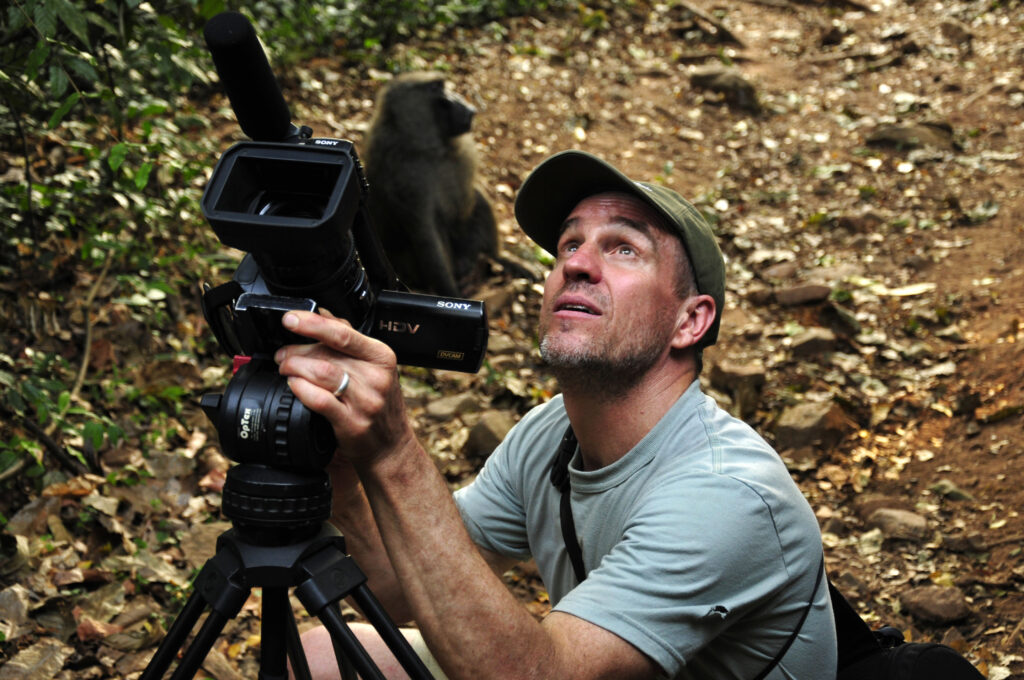
“I met Jane in 1989 as a Peace Corps volunteer in Tanzania. When I could, I would spend time at her house in [Dar es Salaam] cleaning up the Gombe data . . . In the spring of 1992, I received a message from Jane and the research team at Gombe that they needed someone to help habituate the Mitumba community at Gombe to the presence of humans so they could be studied alongside the famous Kasakela community . . . These happy events were the beginnings of my career as a research videographer and filmmaker for JGI.
Even though I am not living full time in Gombe, it is still very close to my heart, as are the chimpanzees, baboons, forest, lake, and all the amazing people there. I still travel to Gombe to film for both internal JGI projects and television programs and series, and I a work a lot with my research archive to provide footage to JGI, the scientific community, and to film-production projects. I also work with the JGI science team to study bioacoustic data we collect at Gombe to enrich our knowledge of the diverse wildlife.”
Dr. Emily Otali
Field Director of the Kibale Chimpanzee Project
“As the Field Director of the Kibale Chimpanzee Project since 2006, I have had countless opportunities to interact with many of Gombe’s researchers and staff (especially the Field Director); through collaborations, visits and meetings at conferences.
A few years ago, I was pleasantly surprised to learn that Gombe named a female chimpanzee after me, Otali. It was a great honor and recognition of my part in chimpanzee research and conservation.”
Dr. Lilian Pintea
Vice President Conservation Science, JGI USA
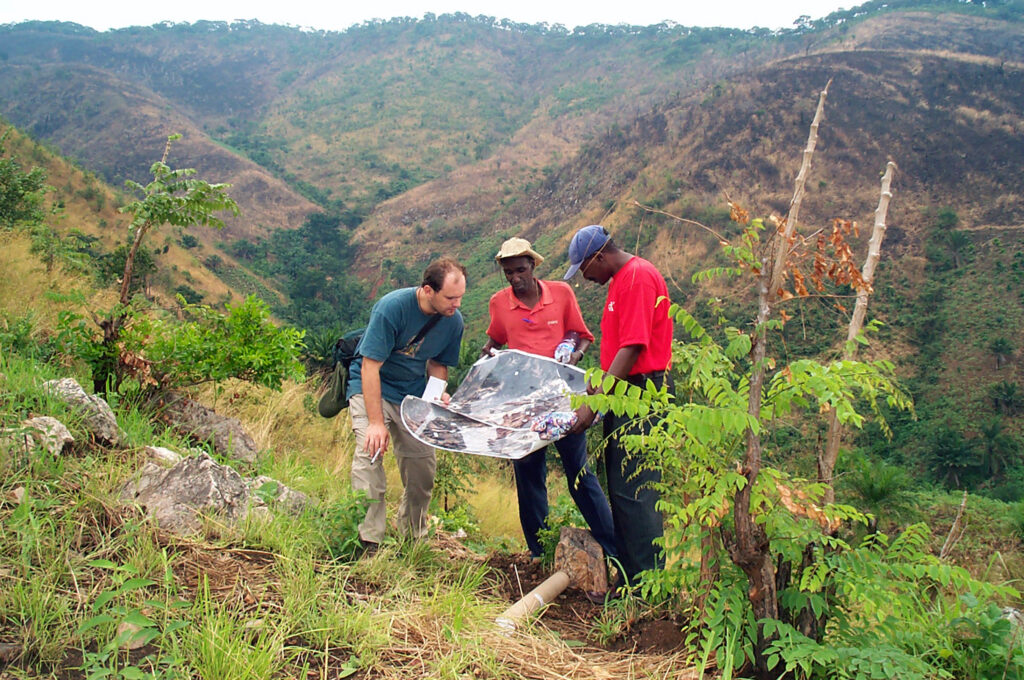
“I started at Gombe as a PhD student in conservation biology with Dr. Anne Pussey at JGI’s Center for Primate Studies at the University of Minnesota back in 2000. My research focused on applying satellite images and geographic information systems — or GIS — to understand the relationships between chimpanzee behavior and habitat change inside and outside Gombe National Park and support our Tacare community-led conservation efforts in the Greater Gombe Ecosystem.
. . .
Today, 25 years later, as vice president of conservation science at JGI USA, I have the honor to continue to support Gombe long-term research, conservation, and education efforts by applying a variety of innovative technologies, from bioacoustics, camera traps, and drones to AI . . .”
Dr. Kate Detwiler
Associate Professor, Biological Sciences Department, Florida Atlantic University
“I went to Gombe as an undergraduate college student participating in a semester abroad program through the African College of wildlife management, known as Mweka, in Moshi. … A previous student had written a report about Gombe’s hybrid monkeys … so I went to Gombe to look for hybrid females and to track their offspring. I found some hybrid moms and was really excited to document that hybrid females in Gombe were fertile.
. . .
My journey today looks very similar. I’m a career scientists and professor, and I collaborate very closely with the Gombe Stream Research Center as one of the Gombe Primary Investigators and am collaborating and guiding and leading the project on that they’ve taken on with the hybrid monkeys. So, we have a habituated group of hybrid monkeys, and we’re tracking females and offspring through multiple generations.”
Dr. Deus Mjungu
Director of JGI’s Gombe Stream Research Center
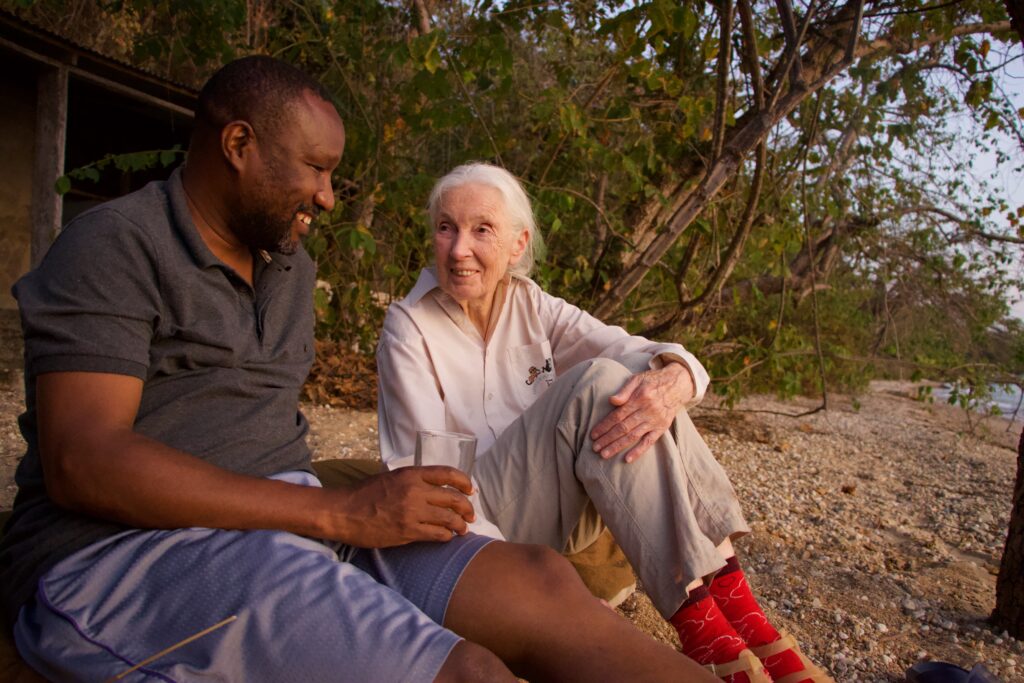
“My Gombe journey began back in 2002. I joined Gombe as a research assistant, and when I came, I was supposed to observe how chimpanzee communities were interacting. By then, the Kasekela chimpanzee community was bigger than the Mitumba chimpanzee community. So, the purpose was just to see how the dynamics were going. I worked on that project for just over a year and then I got a chance to go to do my further studies.
I went to the United States, in Minnesota — University of Minnesota — to do my master’s and PhD . . . Now I’m working as a director of the research center.”
Dr. Jessica Deere
Emory University
“My personal connection to Gombe began through my love of chimpanzees as a young kid. Upon learning about the research and conservation that Jane Goodall helped establish in Gombe, I knew I wanted to one day work there. As my education and career goals advanced, I was drawn to Gombe’s unique potential to explore the intersection of wildlife health, human health, and environmental change. I first traveled to Gombe in 2021 … Since then, I’ve continued to return about twice a year.
Through my role with the Gombe Ecosystem Health Project, I’ve focused on strengthening diagnostic capacity and understanding zoonotic disease risks in wild chimpanzees. I also work on the Gombe One Health Hub to improve our understanding of zoonotic disease risk in the Greater Gombe Ecosystem. Today, Gombe continues to shape my scientific path, and I feel incredibly fortunate to be a part of that story.”
Sims Patton
PhD candidate at The George Washington University
“My Gombe journey began in 2021 when I joined the Primate Behavioral Ecology Lab at The George Washington University in Washington, D.C. I wanted to study primates and how their early lives shape their adult behaviors. The Gombe dataset is the longest and most comprehensive chimpanzee dataset in the world. I knew the research questions I had could be answered with the detailed and consistent records Gombe has kept for 65 years!
I am now a 4th year PhD candidate who has just returned from her first field season at Gombe collecting her own data! It was so cool to be in such a historic place and collect data that will contribute to the long-term database for the next 65 years. I took a picture of my name on the first datasheet I collected with field assistant Baraka Daniel. I am officially in the Gombe record forever! What an honor!”
Abby McClain
PhD candidate at The George Washington University
“My Gombe journey began about five years ago when I decided to apply to do my PhD in primate behavior. Time has really flown and looking back on that journey it’s been cool to see how my knowledge of Gombe has [grown]from general pop culture — knowledge about the history of the site and the amazing influence of Dr. Goodall’s research for not only women in science, but scientists everywhere, and inspiring people to be conservation-minded.
Now, I have just wrapped up my first field season at Gombe and have been back for about a month, and it’s been pretty cool to look back on pictures I took there and think, five years ago I couldn’t identify any of these chimpanzees by sight. And now, we’ve spent a lot of hours in the forest together. So that is how my journey began and where I’m at right now.”
This is just a snapshot of the people contributing to Gombe research, and they have many more stories to share from the field! Read about some of their 🔗 magical moments in the world of Gombe.
P.S. Want to learn more about the history of Gombe research? Check out our 🔗 Gombe storymap!
Photo credits, in order of appearance: Jane Goodall Institute, JGI/Bill Wallauer, Chase Pickering, Nick Riley Photography, JGI/Merlin van Lawick, Sims Patton.


